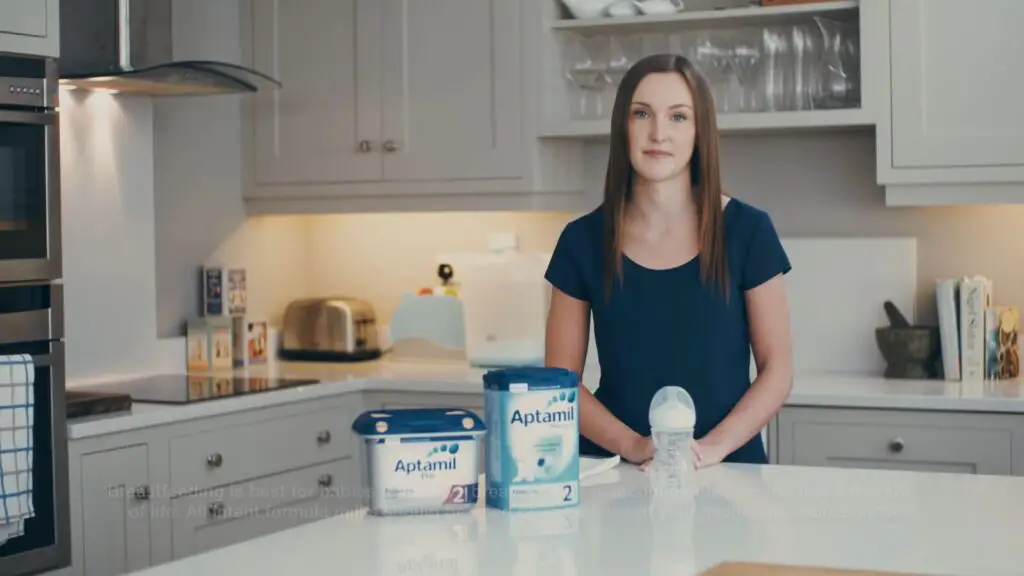Best Bottle Feeding Positions for Your Newborn

The best bottle-feeding positions for your newborn are important to ensure comfort and proper digestion. This article will discuss various positions that are ideal for bottle feeding your baby, providing tips for a successful and enjoyable feeding experience.
When you have a newborn, feeding them is not just about making sure they’re not hungry; it’s also about cuddling them close and making sure they’re comfy and happy while they eat. Just like snuggling into the perfect spot on the couch with a nice, warm blanket, finding the right way to hold your baby during bottle feeding is super important. It’s not only about the warm and fuzzies, though; the way you hold the bottle can make sure your baby gets just the right amount of milk without taking in too much air, which can make their tummy hurt. Plus, when babies are all cozy, they can eat without fussing and that means they can grow big and strong. It’s kind of neat that every baby is like their own little person with likes and dislikes already, so what works for one baby might not be the favorite for another. Some babies like to be held upright, while others might like lying down a bit more. It’s all about getting to know your little bundle of joy and finding out what makes them the happiest during bottle time
Preparing For Bottle Feeding

When it comes to feeding your newborn, bottle feeding can provide flexibility and convenience. Whether you are supplementing with formula or exclusively bottle feeding, it is important to prepare properly for a smooth and successful feeding experience. In this section, we will discuss the importance of cleanliness and the right temperature of the bottle, as well as the selection of an appropriate bottle and nipple to complement feeding positions.
The Importance Of Cleanliness
Ensuring cleanliness is crucial when it comes to bottle feeding your newborn. It helps prevent the risk of contamination and keeps your baby safe from harmful bacteria. Before each feeding, make sure to wash your hands thoroughly with soap and water. Additionally, regularly clean and sterilize the bottles, nipples, and other feeding accessories to maintain hygiene.
To clean the bottles, first dismantle them by removing the nipple, collar, and any other detachable parts. Then, rinse the bottle and parts with warm water to remove any milk residue. Next, use a bottle brush with soapy water to clean the inside and outside of the bottles. Pay extra attention to the nipple and collar, cleaning them with a brush or using hot water to ensure there is no milk buildup. Finally, rinse all the components thoroughly and let them air dry before storing or using them again.
The Right Temperature Of The Bottle
Ensuring the bottle is at the right temperature is essential for your baby’s comfort and safety during feeding. Before offering the bottle, always test the temperature of the milk or formula by applying a few drops on your wrist. It should feel warm, but not hot, to the touch.
To warm the bottle, you can use a bottle warmer or place it in warm water. Avoid using the microwave as it can heat the milk unevenly and create hot spots that may burn your baby’s mouth. If you warm the bottle in warm water, gently swirl it around to distribute the heat evenly. Remember to discard any leftover milk that has not been consumed within two hours.
Appropriate Bottle And Nipple Selection
Choosing an appropriate bottle and nipple is essential for comfortable feeding positions and preventing issues like colic or gas. When selecting a bottle, opt for one with a wide neck for easy filling and cleaning. Additionally, consider bottles with anti-colic features such as venting systems or angled designs.
| Bottle Features | Benefits |
| Wide Neck | Easier filling and cleaning |
| Anti-Colic Features | Reduces chances of colic and gas |
When it comes to nipples, look for slow-flow options specifically designed for newborns. A slow-flow nipple mimics the natural flow of breast milk, allowing your baby to control the pace of feeding. Make sure to select nipples made from soft and flexible materials that are easy for your baby to latch onto.
By prioritizing cleanliness, maintaining the right temperature, and selecting the appropriate bottle and nipple, you can create the perfect foundation for successful bottle feeding. Now that we have covered the importance of preparation, in the next section, we will explore the best bottle-feeding positions for your newborn.
Key Factors To Consider For Bottle Feeding Positions

Bottle feeding your newborn is a beautiful bonding experience, providing nourishment and comfort to your little one. Choosing the right feeding position is crucial for your baby’s comfort, safety, and proper digestion. Additionally, it is equally important to consider the parent’s comfort and ease of feeding. In this article, we will explore the key factors to consider when determining the best bottle-feeding positions for your newborn.
Baby’s Age And Size
As your baby grows and develops, their nutritional needs change, and so does their ability to position themselves during bottle feeding. Hence, your baby’s age and size play a significant role in determining the most suitable feeding position. Here are some factors to keep in mind:
- For newborns: Newborns have limited head and neck control. Hold your baby in a semi-upright position, supporting their head and neck with your hands or by using a nursing pillow.
- For older infants: Once your baby gains more head and neck control, you can transition to other positions. The cradle hold, football hold, or sitting upright with support are popular choices.
- For bigger babies: As your baby grows larger, it may be more comfortable to position them in a semi-reclined position with their head supported on your forearm or a nursing pillow.
Baby’s Comfort And Safety
Your baby’s comfort and safety during feeding are of utmost importance. Here are some factors to consider:
- Supportive positioning: Ensure that your baby’s head, neck, and body are properly supported throughout the feeding session. This helps prevent any strain on your baby’s muscles and allows for a more comfortable experience.
- Avoiding air swallowing: Position the bottle in such a way that the nipple is always filled with milk, minimizing the chance of air swallowing and reducing the risk of colic or gas discomfort.
- Safe head position: Make sure your baby’s head is slightly elevated to avoid any choking hazards. Keeping their head higher than their stomach helps the milk flow smoothly and reduces the chances of reflux.
Parent’s Comfort And Ease Of Feeding
Feeding your baby should also be a comfortable and convenient experience for you as a parent. After all, you both deserve a relaxed and enjoyable bonding time. Consider the following aspects:
- Ergonomic feeding positions: Choose a feeding position that allows you to maintain good posture while comfortably holding your baby. This helps prevent any strain or discomfort in your neck, shoulders, or back during feeding sessions.
- Using support aids: Utilize nursing pillows or cushions to provide additional support for your baby and alleviate any strain on your arms or wrists.
- Creating a soothing environment: Find a quiet, peaceful area without distractions to create a calm atmosphere for both you and your baby during feeding.
By considering the baby’s age and size, prioritizing their comfort and safety, and ensuring the parent’s comfort and ease of feeding, you can establish an optimal bottle-feeding position for your newborn. Remember, every baby is different, so it’s important to observe their cues and adjust the position accordingly to create a nurturing feeding experience.
Recommended Bottle Feeding Positions For Newborns
When it comes to feeding your newborn with a bottle, finding the best position to ensure their comfort and safety is crucial. Not only will finding the right position helps your baby to latch onto the bottle properly, but it can also prevent discomfort and reduce the risk of issues like reflux and gas. In this blog post, we will explore the recommended bottle-feeding positions for newborns. Whether you prefer the cradle hold, cross-cradle hold, football hold, side-lying position, or upright hold, we’ll discuss the benefits of each position and how they can enhance your baby’s feeding experience. So, let’s dive in!
Cradle Hold: Comfortable And Traditional
The cradle hold is a classic and comfortable position for bottle-feeding your newborn. To assume this position:
- Sit in a comfortable chair or position yourself on the edge of your bed.
- Hold your baby in your arms, with their head resting in the crook of your elbow.
- Support your baby’s neck and back with your forearm and hand.
- Use your other hand to hold the bottle and guide it towards your baby’s mouth.
- Ensure your baby’s head is slightly elevated to avoid choking and encourage proper digestion.
The cradle hold allows you to maintain eye contact with your little one, fostering a sense of closeness and bonding during feeding time. It is a popular choice for many parents due to its simplicity and comfort.
Cross-cradle Hold: Enhanced Support And Control
If you’re looking for enhanced support and control during bottle feeding, the cross-cradle hold may be the ideal position for you and your baby. Here’s how to do it:
- Sit in a comfortable chair or position yourself on the edge of your bed.
- Hold your baby in the opposite arm, with their head resting in the crook of your elbow.
- Support your baby’s neck and back with your forearm and hand from the opposite side.
- Use your other hand to hold the bottle and guide it towards your baby’s mouth.
- Keep your baby’s head slightly elevated to facilitate proper swallowing and digestion.
The cross-cradle hold offers extra control and support, making it easier to guide your baby’s latch onto the bottle. This position can be particularly helpful for newborns who may have difficulty latching or need additional assistance.
Football Hold: Ideal For Reflux Or C-section Moms
The football hold, also known as the clutch or underarm hold, is a go-to position for moms who have had a C-section or babies experiencing reflux. Here are the steps to practice the football hold:
- Sit in a comfortable chair or position yourself on the edge of your bed.
- Place a pillow or nursing pillow on your lap to support your baby.
- Position your baby’s body alongside your side, tucking their legs under your arm.
- Support your baby’s head and neck with your hand.
- Use your other hand to hold the bottle and guide it towards your baby’s mouth.
The football hold keeps your baby elevated and upright, which can help alleviate discomfort caused by reflux. It also allows moms who’ve had a C-section to avoid putting pressure on their incision area. This position offers excellent visibility, and you can easily monitor your baby’s feeding progression.
Side-lying Position: Relaxing And Convenient
The side-lying position provides a relaxing and convenient way to feed your baby, especially during nighttime feedings. Follow these steps to achieve the side-lying position:
- Lie down on your side, either on a bed or a comfortable surface.
- Place your baby facing you, parallel to your body.
- Support your baby’s head and neck with your arm.
- Use your other hand to hold the bottle and guide it towards your baby’s mouth.
- Ensure your baby’s head is slightly elevated, allowing for easier swallowing.
The side-lying position is a great option for tired parents as it enables you to rest while feeding your baby. It is also beneficial for babies who have a preference for latching while lying down.
Upright Hold: Reducing Acid Reflux And Gas
The upright hold is a position that can help reduce acid reflux and gas in your baby. Here’s how to achieve this position:
- Sit in a comfortable chair or position yourself on the edge of your bed.
- Hold your baby in an upright position, with their head supported by your palm.
- Use your other hand to hold the bottle and guide it towards your baby’s mouth.
The upright hold keeps your baby in an upright position, allowing gravity to aid digestion and preventing the flow of milk in the wrong direction. This position is particularly useful for babies who tend to spit up frequently or suffer from acid reflux.
Tips For Proper Technique When Bottle Feeding
When it comes to bottle feeding your newborn, proper technique is essential for a smooth and comfortable experience. Not only does it ensure that your baby gets the right amount of nourishment, but it also helps in building a strong bond between you and your little one.
Maintain Eye Contact And Establish a Connection
One of the most important aspects of bottle feeding is maintaining eye contact with your baby and establishing a connection. This helps create a sense of trust and security, making the feeding experience more enjoyable for both of you. By looking into your baby’s eyes as you feed, you can engage their attention and provide them with a comforting presence.
Support Baby’s Neck And Head Position
Supporting your baby’s neck and head is crucial to ensure their comfort and safety during feedings. It is essential to hold your baby in a semi-upright position, with their head and neck properly supported. Gently cradle your baby’s head in the crook of your arm, using your hand to support their neck and jaw. This not only allows for easier swallowing but also reduces the risk of choking.
Allow For Frequent Burping Breaks
During bottle feeding, babies tend to swallow air along with milk, leading to discomfort and gas. To avoid this, it is important to allow for frequent burping breaks throughout the feeding session. Gently patting your baby’s back or holding them upright against your shoulder can help release trapped air and prevent excessive fussiness or colic. Remember to take these breaks at regular intervals, offering your baby a chance to digest their food properly.
Potential Challenges And Solutions For Bottle Feeding Positions

When it comes to bottle feeding your newborn, finding the best position that ensures both comfort and efficiency can be a bit of a trial-and-error process. Every baby is unique and may have different preferences when it comes to feeding. However, challenges in the bottle-feeding positions are not uncommon, and with a little experimentation and patience, you can find the perfect solution for your little one. Below are some potential challenges you may encounter during bottle feeding, along with suggested solutions to help you navigate through them.
Fussy Or Uncooperative Baby
It can be disheartening and frustrating when your baby becomes fussy or uncooperative during bottle feeding. They may turn their head away, push the bottle away with their hands, or simply refuse to latch onto the nipple. This can impede the feeding process and lead to stress for both you and your baby. Fear not, as there are a few solutions that can help:
- Ensure a calm and quiet environment: Find a peaceful spot in your home where you can minimize distractions and noise. This can create a soothing atmosphere that helps to calm your baby during feedings.
- Try different nipple shapes and sizes: Babies have varying preferences when it comes to bottle nipples. Some may prefer a wide-base nipple, while others may prefer a narrow one. Experimenting with different shapes and sizes can help you find a nipple that your baby feels comfortable with and can latch onto easily.
- Hold your baby in an upright position: Some babies may have difficulties swallowing milk if they are lying flat. Holding your baby in a slightly upright position can aid in digestion and reduce the chances of discomfort during feeding.
Bottle Nipple Choices For Enhanced Feeding Experience
The type of bottle nipple you choose can significantly impact your baby’s feeding experience. Here are some suggestions to consider:
- Wide-base nipples for easy latching: Wide-base nipples mimic the shape and feel of a mother’s breast, making it easier for your baby to latch onto the bottle.
- Vented nipples to reduce gas and colic: If you notice your baby experiencing discomfort or suffering from excessive gas and colic, consider using vented nipples. These nipples are designed to release air during feeding, reducing the chances of gas buildup.
- Variable flow nipples for older babies: As your baby grows, they may require a faster milk flow. Variable flow nipples allow you to adjust the flow rate to accommodate your baby’s developmental needs.
- Silicone or latex nipples: Bottle nipples are typically made of either silicone or latex. Silicone nipples are more durable and resistant to heat, while latex nipples have a softer and more natural feel.
As you explore different positions, pay attention to your baby’s comfort level, their ability to latch onto the nipple, and the overall ease of feeding. Remember, finding the optimal position may take time, but with patience and experimentation, you’ll discover what works best for your little one.
Common Mistakes To Avoid When Bottle Feeding
Discover the best positions for bottle-feeding your newborn to avoid common mistakes. Optimal positioning can provide comfort for both you and your baby, ensuring a successful and enjoyable feeding experience.
Proper bottle feeding technique is essential for the health and well-being of your newborn. Avoiding certain mistakes can ensure that your baby is getting the right amount of nutrition while minimizing the risk of discomfort or potential health issues. In this section, we will explore three common bottle-feeding mistakes to avoid: overfeeding or underfeeding, feeding the baby in a lying down position, and ignoring the baby’s cues for pause or satiety.
Overfeeding Or Underfeeding
Ensuring that your baby is receiving the right amount of formula or breast milk is crucial. Overfeeding can lead to uncomfortable symptoms, such as excessive spitting up, colic, and weight gain issues. On the other hand, underfeeding can result in inadequate nutrition and potentially poor growth. To avoid these issues, it is important to follow your baby’s feeding cues and work with your pediatrician to establish the appropriate feeding schedule and amount.
Feeding Baby In A Lying Down Position
Feeding your baby in an upright position is recommended to prevent issues like ear infections and choking hazards. When a baby is lying down during a feeding, there is a higher chance of milk flowing into the middle ear, which can lead to discomfort and potential infections. Additionally, feeding in an upright position allows for better digestion and minimizes the risk of aspiration. Keep your baby’s head elevated during feedings and ensure they are positioned at a slight angle to promote proper swallowing.
Ignoring Baby’s Cues For Pause Or Satiety
Your baby communicates their hunger and fullness cues through various signs and signals. It is important to pay attention to these cues and respond accordingly during bottle feedings. Ignoring these signals can lead to overfeeding or underfeeding. Babies may turn their heads away, slow down their sucking, or become less interested in feeding when they are satisfied. By recognizing and respecting these cues, you can foster a healthy feeding relationship and help your baby develop self-regulation skills.
Frequently Asked Questions Of Best Bottle Feeding Positions For Your Newborn
What Are The Best Bottle Feeding Positions For Newborns?
Newborns can be comfortably fed in positions such as cradle hold, football hold, and cross-cradle hold.
Can I Bottle Feed, My Newborn, While Lying Down?
Yes, you can bottle feed your newborn while lying down, but ensure their head is elevated to prevent choking.
How Often Should I Change Bottle Feeding Positions During A Feeding Session?
It is recommended to change bottle feeding positions every 5-10 minutes to prevent discomfort and aid digestion.
Are There Specific Bottle Feeding Positions For Newborns With Reflux?
For newborns with reflux, upright positions like semi-recline or high chair can help reduce symptoms and prevent regurgitation.
Should I Try Different Bottle Feeding Positions If My Newborn Seems Fussy?
Yes, experimenting with different bottle-feeding positions can help soothe a fussy newborn and promote better feeding.
Conclusion
To ensure your newborn’s comfort during bottle feeding, it’s crucial to find the best position that works for both of you. Experiment with different options like the cradle hold, cross-cradle hold, or football hold to find what suits your baby’s needs.
Remember to maintain proper support for their head and neck throughout the feeding process. By adopting these ideal bottle-feeding positions, you can create a peaceful and enjoyable bonding experience with your little one.






